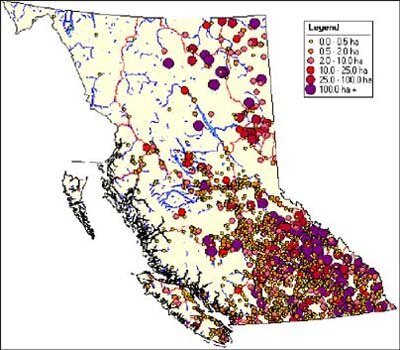Using satellites in the fight against forest fires
Real-time Emergency Management via Satellite (REMSAT) is proving itself to be a valuable component in fighting Canadian forest fires.
In the recent dramatic fires in Lillooet Canada the results of using this system quickly met the expectations of the British Columbia Forest Service.
Throughout 2004, several major demonstrations took place, all in the Canadian province of British Columbia. In the first demonstration, the REMSAT system received its commissioning at Chilko Lake, the scene of a fierce fire the previous year. This gave testers the opportunity to compare REMSAT II's capabilities to already existing equipment.
The demonstration proved the equipment's ability to withstand transport across rugged terrain, often no more than dirt tracks, and could be deployed in 20 minutes of arrival. BC firefighters are often transported by helicopter or even dropped by parachute into remote areas; the advanced communications provided by REMSAT II meant that fire crews could reach areas never before accessible.

The original concept of REMSAT II was to provide a cost effective end-to-end system capable for a diverse range of emergency services. Initiated by the European Space Agency (ESA), REMSAT II was developed by Telesat Canada, Simon Fraser University, the British Columbia Forest Service and the Communications Research Centre all from Canada. It is the first such system in the world and the trials have shown it able to transmit more information from the front lines of wildfires relieving pressure on overcrowded radio frequencies.
Although several different architectures are possible, a typical one is essentially comprised of three tiers: the Control Centre Terminal (CCT), the Intermediate Mobile Terminal (IMT) and the all-important Handheld User Terminal (HUT) worn as a backpack. A GPS satellite monitors the HUT equipped firefighter, who can transmit his position to a ground station managed by the IMT, a transportable terminal with no need for terrestrial infrastructure. The IMT, in turn, transmits to a telecommunications satellite, which then passes the data to the CCT. The CCT acts as the main headquarters and is equipped with high bandwidth communications for voice and data.

A more advanced configuration has the HUT transmitting directly to a satellite and then to the CCT via a ground station and the Internet. Earth Observation satellites are also involved in both configurations, providing real-time information to all components.
The entire system is equipped with a variety of file storage and transfer capabilities, including email and fax, Internet, voice communication and point-to-point video in real time. REMSAT II provides several data rates for each tier from 512 kbps to 1.2 kbps, through VHF local radio networks.
The most recent demonstration in Lillooet confirmed REMSAT II's advantages. BC Provincial Fire Information Officer, Nancy Argyle said "It provides us with an extra safety angle because we are able to communicate better and we can send digital messages to our firefighters."

Almost twice the size of France and with most terrain inaccessible by road, the Canadian province of British Columbia is plagued by more than 2500 forest fires every year, burning over 20,000 hectares.
REMSAT II, along with the Spanish equivalent RemiFireSat is a follow-up on an earlier similarly named project. It is an excellent demonstration of satcom technology with a direct application to Earth based needs. Telesat plans to make the system flexible enough for other types of emergencies, such as flood and earthquake. Several other countries have expressed an interest in the system including Russia whose own underdeveloped infrastructure makes REMSAT II an ideal solution.





